A Few Stories from our Weeks in Mumbai
Please view the photo gallery as well--Click on individual photos for short descriptions
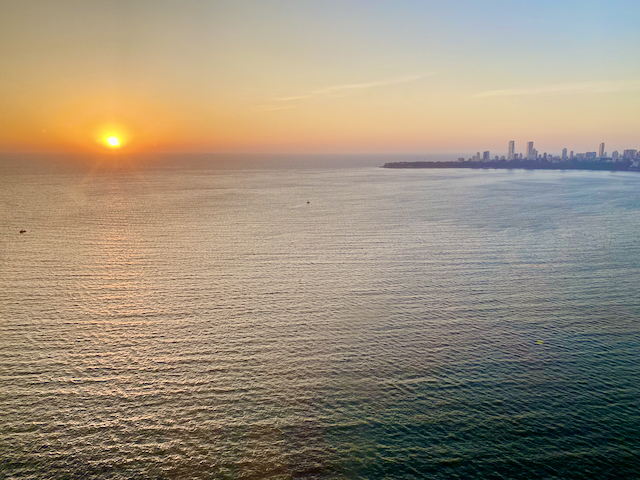
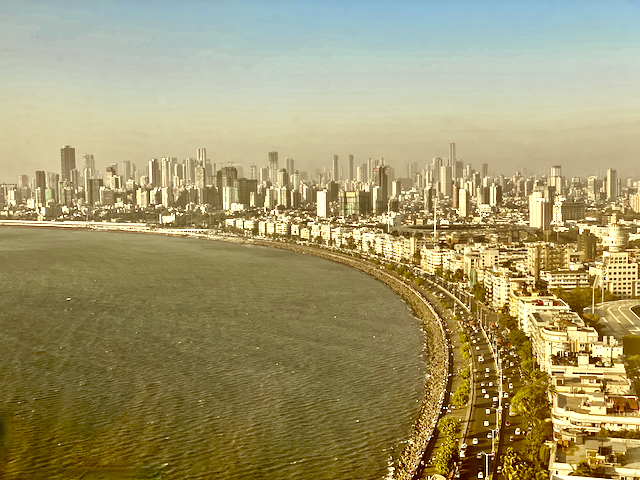
A FEW STORIES FROM OUR WEEKS IN MUMBAI
Susan booked our apartment from Reno through AirB&B. Our landlady looked at Susan’s Facebook page the day before we arrived and discovered that we have at least seventeen common FB friends, all Mumbai musicians! Our apartment hostess is an accomplished singer herself and a new friend. India is a paradise for fruit. And for the first time, we are visiting late enough in Spring to enjoy the delicious mango season, for which India is famous.
This plate shows my favorite breakfast,which includes mangos, papayas (seasoned by lime juice), pineapple, watermelon, grapes, bananas, and oranges.
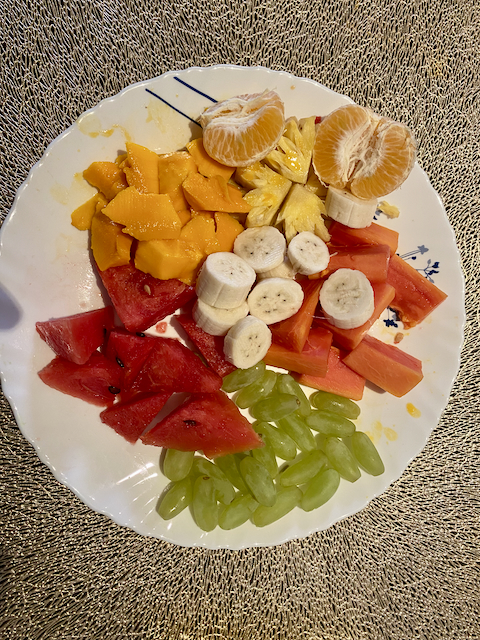
INDIAN RESTAURANTS
I continue to repeat the phrase “every meal is an adventure.” In the US, “Indian food” is regarded as a spicy ethnic cuisine, maybe a little similar to Mexican food, since both cuisines regularly use hot peppers. The fact is that India is a complex country that includes twenty-two unique languages, with distinct cuisines associated with each ethnic group. Some generalizations can be made. For example, North Indian food uses ghee (clarified butter) and yogurt in many dishes, whereas South Indian food typically uses coconut milk. I have visited India at least fifteen times over the years, and I experience new dishes every time I visit.
It's interesting that in Mumbai, a huge cosmopolitan city, there are trendy restaurants that are serving American-style dishes…burgers, avocado toast, pizzas, etc. Starbucks has a large presence here, as well as McDonalds and Pizza Hut. Perhaps the oldest foreign cuisine in India is Chinese food. Chinese immigrants were some of the earliest arrivals. I love Chinese food in India. It’s spicier than American-Chinese food, due to the “saturated palates” of the Indian public. For Susan’s and my recent 37th-anniversary dinner, we dined at an upscale Chinese restaurant that is truly one of the best I’ve ever enjoyed.
Our dear friends Meagan (Susan’s harp student) and her husband Vijay took us to a traditional South Indian restaurant in which the vegetarian meal was served on a banana leaf. This was great for Susan, who is a longtime vegan. But Vijay and Meagan also ordered chicken and lamb dishes to augment the traditional vegetarian fare. Everything was quite spicey.
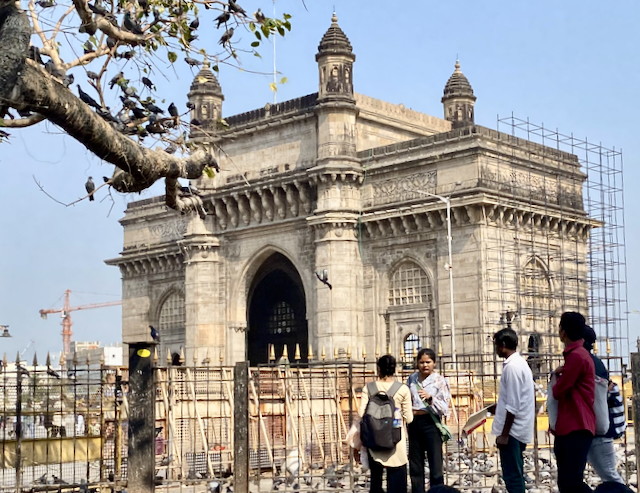
Above is the famous “Gateway to India,” located on the inner harbor and adjacent to the famous Taj Mahal hotel. The Gateway is in the process of refurbishment.
MY HAIRCUT
Luckily, I still have plenty of hair at my advanced age. It keeps growing, such that Susan insisted that I couldn’t wait until we’re home again to get my hair cut. I asked a good friend who recommended his upscale salon. This was a full-service hair salon! The ambiance included loud music playing, similar to what one would hear at a bar or nightclub.
I had an appointment with my friend’s usual hairdresser. After being introduced to her, she assessed my long hair and asked what kind of haircut I wanted. I told her that as a lifelong musician, I had always worn my hair long, but that now it was just too long.
First, she sent me to the hair-washing station, where a young man shampooed my hair and gave me a little scalp massage in the process. Next, I was offered the coffee of my choice. I chose a latte, which was served in a Starbucks cup, so I assumed it was Starbucks coffee. Then she cut my hair, asking me regularly if I liked how much she was cutting off. Finally, she asked me if I wanted my beard trimmed. When I said yes, she led me to a different part of the salon where I was seated to be served by the beard specialist.
The beard specialist asked if I was comfortable with him using a razor. I answered yes. So he sharpened his straight razor and carefully shaved my neck and cheeks, while “shaping” the border of my beard. He used a clipper to evenly trim my beard, also clipping my eyebrows and ear-hairs. My beard and mustache are certainly shorter than I’ve usually worn them, but Susan loved my new look.
The charge for this comprehensive hair care was around $30. This is certainly a price that is impossible for typical Indians to afford. But we are residing in the upscale “Hollywood” part of town, which here is known as Bollywood. I assumed this upscale salon where I was getting my haircut is where the Bollywood movie stars come for their luxury hair care.
The photo below shows a slum area adjacent to the opulent numerous high-rise buildings.
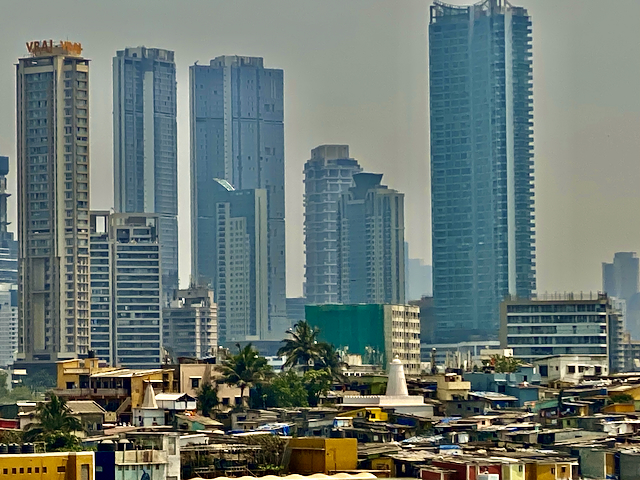
MY CULTURAL FAUX PAS
Our apartment complex is typical insofar as all such apartment buildings have 24-hour watchmen on duty. Our building’s watchmen wear uniforms and greet us as we come and go. Vijay, the husband of Susan’s harp student Meagan, has valiantly carried Susan’s harp up and down the flight of stairs to our second-story apartment. There is no elevator.
One time Vijay asked one of the guards to help him carry the harp. (Vijay never lets me help him, even though I have years of experience moving Susan’s harps.) It is customary for people to take off their shoes when they enter a residence. (This is also typical in Sweden.) The workman-guard took off his shoes upon entering our apartment to help Vijay. As they carried the harp, the guard did not manage to put on his shoes, walking barefoot down the staircase and outside into the parking lot to Vijay’s vehicle. Trying to be helpful, I picked up the guard’s shoes and carried them down the stairs, following the harp being carried by Vijay and the guard.
This was my cultural faux pas. Shoes (and bare feet) are considered to be dirty. For example, it is regarded as an insult to point the bottom of one’s feet toward another person. Vijay informed me that the workman was “lower caste,” and so it is culturally inappropriate to touch (or carry) his shoes. Interestingly, since then when we see the guard every day, he gives me a big smile. We plan to give him a tip of 500 rupees when we leave. It’s not much for us but will be much appreciated by him. Even though the caste system has been “illegal” for many years, it persists culturally, especially in rural areas. I hadn’t given it a thought until this episode with the guard’s shoes.
On the positive side of Indian traditions regarding feet, people show respect to their teachers, gurus, and leaders by touching their feet. This gesture of respect is symbolically saying, “You are so great, and I am lower than your feet.”
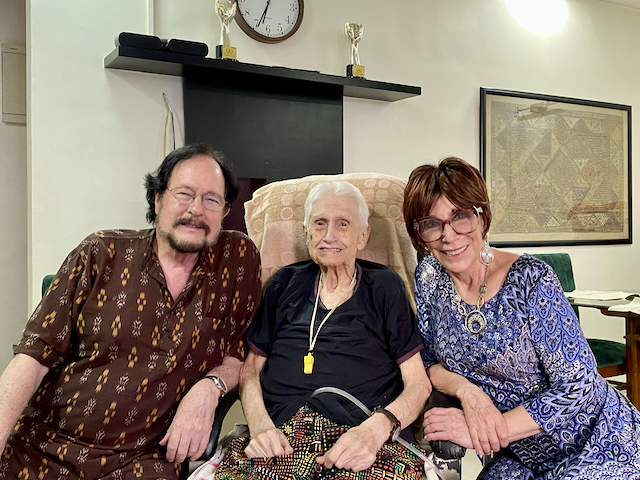
Above is our 96-year-old American friend and longtime Mumbai resident Bob Carr.
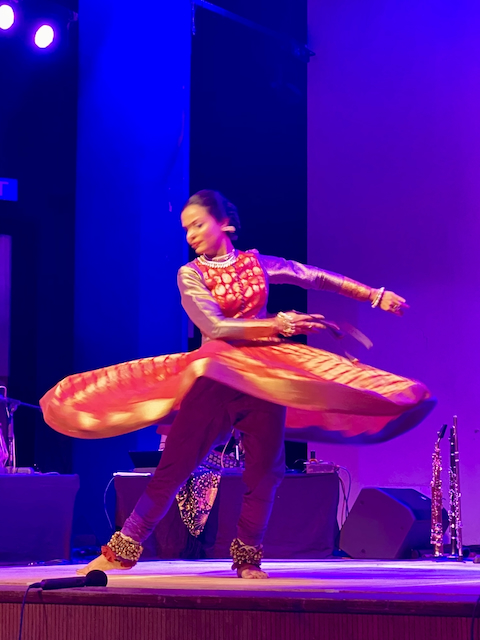
Above, Kathak dance star Aditi Bhagwat
OUR MUSICAL EVENTS
The main goal of spending six weeks in Mumbai was to play music, and we have achieved that goal with the help of friends here. Vijay, our friend and energetic harp mover, arranged several performances, including an international convention of attorneys on the 33rd floor of the Oberoi Hotel, and performing at a music school where the students in the audience were especially enthusiastic. I performed on a weekly basis at jazz clubs with my American bass-player-friend Dee Wood. Dee and his partner Rajesh are founders of the Bombay Jazz Club, an organization dedicated to promoting artists and concerts in Mumbai and beyond.
Our primary music collaborator has been Kathak dancer Aditi Bhagwat. Aditi has visited and performed in our Reno home concerts twice. We performed with her for several years in Mumbai pre-covid. This year we performed once again at the Prithvi Theater, which is comparable to Reno Little Theater in size and ambiance. Aditi has also performed with us previously at the Reno Little Theater, and another concert is planned with her there this coming August. Another performer who had played with us in Reno is tabla player Unmesh Bannerjee. He joined Aditi, Susan, and me for this year’s Prithvi Theater concert.
My first music tour to India took place in 1982, when I was part of the late Kathak master Chitesh Das’s dance troupe. We performed that year in Calcutta, Delhi, Jaipur, and Mumbai. While in Mumbai that year, tabla master Zakir Hussain introduced me to the “godfather of Indian jazz,” Louiz Banks. Louiz is eighty-two years old and still in top form. I have played with Louiz whenever I was able to do so during previous visits. Many times I would visit Louiz in his home studio and sightread some of Louiz’s original compositions. He likes the fact that I am a good sightreader.
During this visit, Louiz was a special guest at our Prithvi Theater concert, playing two numbers with Susan and me. Due to his fame, the audience gave Louiz a standing ovation when he came on stage. I also had the pleasure of playing one evening at a jazz club called the Blue Bop. Joining Louiz and me were India’s top rhythm section of Louiz’s son Gino Banks on drums and Sheldon D’Silva on bass. I was high from the music for days. I told Louiz that it was a comparable experience to having played with Ahmad Jamal and his excellent rhythm section. Louiz and his colleagues would be musically at home in New York, Los Angeles, or any jazz venue in the world. They are clearly world-class musicians.

Above, Aditi Bhagwat and Louiz Banks, in a photo taken in our lovely B&B apartment on the occasion of a meeting to plan our performance at the Prithvi Theater.
LATER THIS YEAR
I have mentioned that Susan and I are in our bucket list phase of life. For me, that means more travel and more music. This trip truly appealed to Susan because it is the first time that she was able to play her own harp for our concerts here. She has two harps in Reno. This third harp (which she purchased from her beloved teacher some years ago) will stay in Mumbai to be available for future visits. Meagan and Vijay will take good care of it.
Besides our closest longtime friends, we have met new people and made contacts for future musical engagements. Thus we plan to return to Mumbai for some weeks this coming November and December. Those months are known as the beginning of the winter concert season. They are also known as the wedding season. So this means that Susan and I will probably have more concert/gig offers than we can perform. It is ironic that while we are “retired” in Reno, we find ourselves working more than ever musically in Mumbai.
We also hope to include some sightseeing in India and Nepal, as well as a potential concert in Hong Kong. This coming Monday, we will travel by overnight train to Khajuraho, which is an ancient city famous for its temples containing numerous erotic sculptures. Khajuraho will be followed by visiting dear friends in Delhi for two nights before finally returning to Mumbai to catch our return flight home to Reno, via Paris and Los Angeles. I intend to send out an additional blog about Khajuraho with photos after I arrive back in Reno.
Below, wearing my best kurta (Indian shirt) for a corporate gig:
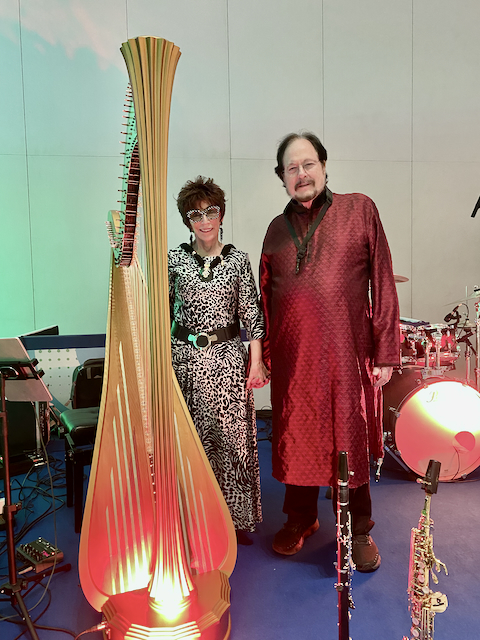
0 Comments on A Few Stories from our Weeks in Mumbai
Join the Conversation